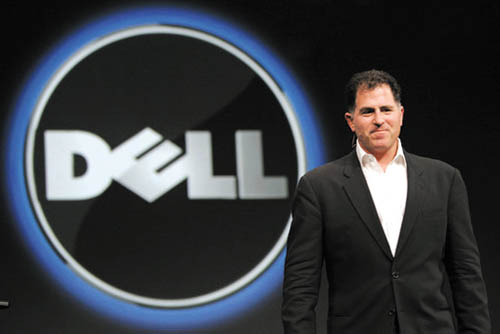 电脑制造商戴尔公司(Dell)最后能否顺利逆转?迈克尔•戴尔一手开创了这家公司,并看着它逐步发展壮大。五年前,戴尔重回公司一线掌舵,现在的戴尔公司在很可能会再续辉煌。公司接下来能否强势回归,未来数月将非常关键。
电脑制造商戴尔公司(Dell)最后能否顺利逆转?迈克尔•戴尔一手开创了这家公司,并看着它逐步发展壮大。五年前,戴尔重回公司一线掌舵,现在的戴尔公司在很可能会再续辉煌。公司接下来能否强势回归,未来数月将非常关键。
戴尔股票在1995年到2000年初的几年时间里经历了辉煌的增长,即使在科技板块也名列前茅。公司股价上涨近9倍,达到每股59美元。互联网泡沫破裂后,2000年底戴尔公司股价跌至16美元。由于戴尔品牌在个人电脑市场仍有很强实力,公司股价在接下来的四年里反弹至42美元。这四年里,戴尔在高效生产和组装个人定制化电脑方面获得了很高声誉,并成为市场领导者。
但是,2005年迈克尔•戴尔不再担任首席执行官职务后,公司股价又开始下滑,2006年初股价已跌至20美元以下。惠普公司(Hewlett-Packard)和宏基(Acer)等中国制造商开始在笔记本领域展开更激烈的竞争。迈克尔•戴尔2007年重返公司担任首席执行官,誓言重振公司。
但惠普公司的切身经历显示,重振一个科技巨头并非易事,可能需要多年的努力。2009年2月,经济大萧条环境使得戴尔股票跌至8美元。此后,公司股价反弹到15美元上下,并在该水平徘徊数年。与此同时,上网本以及后来的iPad等平板电脑成为热门产品,个人电脑和笔记本电脑的增速因此放慢。似乎突然之间,风云变幻的电脑业界已经进入了“后个人电脑世界”,让曾经参与开创现代个人电脑时代的戴尔公司措手不及。
但今年,戴尔公司股票释放出的讯息表明,投资者已经重拾对戴尔的信心。2月份,戴尔股价攀升至18.33美元,这意味着从年初到2月份它的股价已经上涨了25%。其中主要原因是:戴尔减少了对个人电脑和笔记本销售的依赖,而是将重心转向服务、服务器和存储器销售,而且这些举措已开始奏效。与此同时,戴尔还努力推出更高端的个人电脑产品,避免与苹果公司(Apple)的iPad和亚马逊公司(Amazon)的Kindle Fires平板电脑直接竞争。
过去的六个财年中,个人电脑和笔记本收益占戴尔总收益的份额从65%下降至54%。而同期服务器业务占总收益的百分比已经从10%增长到了13%。为公司客户提供咨询和处理IT事务的服务部门为总收益的贡献比例则从8%上升到了13%,其中一部分原因是戴尔收购的若干公司,比如以39亿美元收购的IT服务公司Perot Systems,以及没有透露收购价格的云计算公司Boomi。
过去几个月内,戴尔加快了在服务领域的收购步伐。2月份,戴尔收购了备份软件供应商AppAssure公司。仅一个月后,戴尔又收购了网络安全企业Sonicwall。上周,有传闻显示,戴尔正准备出价3.75亿美元收购瘦客户端系统制造商Wyse公司,以及另一家IT服务公司Clerity Solutions,收购价预计为10亿美元。
这些举措相当令人振奋,说明戴尔公司正把重点转向自身增长领域。上一财年,戴尔公司个人电脑销售额下跌了4%,而笔记本和平板电脑销售额上涨了1%。同时,服务器销售额增长了10%,服务部门销售额增长了8%。
尽管后个人电脑时代的说法甚嚣尘上,但整体看来,戴尔的表现还算不错。2011年最后一个季度,戴尔在个人电脑市场所占份额从一年前的11.6%上升至12.6%。而同时,惠普的份额从18.8%下降至16%,而联想(Lenovo)的份额则从11.3%增加到了14%。
戴尔还通过努力推进高端XPS系列笔记本来弥补其低端笔记本业务的下滑。今年年底,微软公司将要推出Windows 8,可能也会刺激对新型个人电脑和笔记本的需求,尤其是希望升级换代、采用新版操作软件的公司客户。
戴尔公司还重点开发了企业和政府客户,以此来弥补个人电脑销售额的下跌。企业和政府销售额占到总额的80%。戴尔在大公司销售方面取得了成功。个人消费者销售额占总收入的比例从两年前的23%下降到了19%,而大公司销售额的比例从两年前的27%上升到了30%。大公司销售的利润更高,营业利润可达销售额的10%,而消费者销售营业利润只有2.7%。
因此,戴尔公司的总收益在过去数年内增长了17%。同期营业利润也从4.1%上升至7.1%。而戴尔公司股票的市盈率仍然仅为7.7,仅为标准普尔500市盈率14.8的一半。
因此,戴尔未来仍然面临挑战,投资者们依然不敢对戴尔前景过于乐观。其中一个原因是,中国公司开始在低端服务器领域展开有力竞争,而这正是戴尔的增长领域。同时,支持高端笔记本的英特尔(Intel)Ivy Bridge芯片又将推迟发布时间。
尽管杰富瑞投行(Jefferies & Co.)分析师皮特•米塞克表示,把业绩不佳归咎于泰国洪灾的说法实际上是“掩饰需求减缓趋势的障眼法”,比如iPad人气日益高涨带来的影响。
但去年的洪灾确实严重影响了硬盘驱动器的供应。Windows 8在平板电脑上的运行能力进一步推高了个人电脑的售价,甚至个人电脑所用的配件价格也在缓步走高。
最近几周,这些忧虑给戴尔的股票形势构成了压力,导致其股价从2月份的高点下跌了10%。戴尔公司用了将近五年的时间才开始赢得投资者的支持,至少还需几个月戴尔才能顺利度过公司核心业务——个人电脑所面临的难关。如果戴尔能经受住考验,它的强势回归将指日可待!
Is Dell finally turning a corner? Five years after Michael Dell returned to lead the PC maker he founded and transformed into a colossus, Dell may actually be ready for a second act. But the next several months will be crucial in determining how strong any recovery will be.
Between 1995 and early 2000, Dell's (DELL) stock enjoyed one of the biggest rallies -- even for the tech sector -- rising nearly 900% to $59 a share. The dot-com crash brought it back down to $16 share by the end of 2000, but the strength of its brand in the PC market helped Dell rebound to $42 over the next four years as Dell's reputation for efficient manufacturing and assembling customized PCs made it the market leader.
But in 2005, following the departure of Michael Dell as CEO, Dell's stock began to decline again, pushing the price back down below $20 a share in early 2006. Hewlett-Packard (HPQ) and Chinese manufacturers such as Acer began competing harder in laptops. Michael Dell returned as CEO in 2007, vowing to revive the company.
But as HP is learning, turning a tech giant around is a grueling process that can take years. In February 2009, the Great Recession brought Dell's stock down to $8 a share. After that, it rebounded to and hovered around the $15 mark for a few years. Meanwhile, netbooks and then the iPad and other tablets became hot items, slowing growth rates for PCs and laptops. The company that helped invent the modern PC company was suddenly living in a "post-PC world."
But this year, the company’s stock is signaling that investors are starting to believe in Dell again. The stock rose to $18.33 a share in February, marking a 25% gain from the beginning of the year. The key reasons: Dell’s efforts to rely less on PC and laptop sales and more on services, servers and storage are working. Meanwhile, the company is pushing harder into higher-end PCs so it doesn’t have to compete with Apple’s (AAPL) iPads and Amazon’s (AMZN) Kindle Fires.
Over the past six fiscal years, PCs and laptops have shrunk from 65% of revenue to 54%. Meanwhile, servers have gone from 10% to 3%, while the services division, which includes consulting and handling IT for companies, has risen from 8% to 13%, partly through acquisitions of companies like Perot Systems, an IT services company, for $3.9 billion and Boomi, a cloud-computing company, for an undisclosed sum.
Over the past several months, Dell has stepped up the pace of its acquisitions in the services area. In February, it bought AppAssure, a backup software vendor. A month later it bought network-security firm Sonicwall. And in the past week, news emerged that it's buying Wyse, a maker of thin-client systems, for $375 million as well as Clerity Solutions, another IT services company for an estimated $1 billion.
These moves are encouraging because they show Dell is focusing on its areas of growth. In its last fiscal year, PC sales fell 4% while laptop and tablet sales rose 1%. Meanwhile, sales from servers grew by 10% and sales from its services division grew by 8%.
And despite all the talk of a post-PC era, Dell isn't doing too badly all things considered. In the last quarter of 2011, Dell's share of the PC market rose to 12.6% from 11.6% a year earlier. HP's share, meanwhile, fell to 16% from 18.8%, but Lenovo's share rose from 11.3% to 14%.
The company also managed to offset declines in its lower end laptops by pushing harder on its higher-end XPS line of notebooks. And the arrival of Microsoft's (MSFT) Windows 8 later this year will likely trigger a demand for new PCs and laptops, especially as companies upgrade to new the operating software.
Dell has also fought off a decline in consumer sales by focusing on businesses and governments, which make up 80% of its sales. Dell has had success in selling to big companies. Sales to consumers fell to 19% of its total revenue last year from 23% two years ago. But sales to big companies rose to 30% of total revenue from 27% in the same period. Those big-company sales lead to higher margins: Operating profit in that segment were equal to 10% of its sales, while the operating profit from the consumer segment was 2.7%.
As a result, Dell's total revenue grew by 17% over the past few years and its operating margin increased from 4.1% to 7.1% in the same period. The stock, however, still trades at only 7.7 times its earnings, about half of the 14.8 P/E for the S&P 500.
For all that, Dell has some challenges ahead that are keeping investors from feeling too bullish. For one, Chinese companies are starting to get aggressive in the low-end servers that has been an area of growth for Dell. Intel's (INTC) Ivy Bridge chip, which powers higher-end laptops, is facing a delay.
And the flooding in Thailand late last year disrupted the supply of hard disk drives, although one analyst, Jefferies & Co.'s Peter Misek, has said he thinks that all the talk about Thai floods is really "a smokescreen to mask underlying slower demand trends," such as the increasing popularity of iPads. The ability of Windows 8 to run on tablets could also pressure PC prices further, even as the components used to make PCs inch higher.
Those concerns have weighed on Dell's stock in recent weeks, causing it to drop 10% from its February high. Dell's turnaround has taken nearly five years to start winning over investors. It has at least a few more months of hazards to navigate in the PC business still at its core. But if it can weather them, the company's second act could be a strong one.
 电脑制造商戴尔公司(Dell)最后能否顺利逆转?迈克尔•戴尔一手开创了这家公司,并看着它逐步发展壮大。五年前,戴尔重回公司一线掌舵,现在的戴尔公司在很可能会再续辉煌。公司接下来能否强势回归,未来数月将非常关键。
电脑制造商戴尔公司(Dell)最后能否顺利逆转?迈克尔•戴尔一手开创了这家公司,并看着它逐步发展壮大。五年前,戴尔重回公司一线掌舵,现在的戴尔公司在很可能会再续辉煌。公司接下来能否强势回归,未来数月将非常关键。
